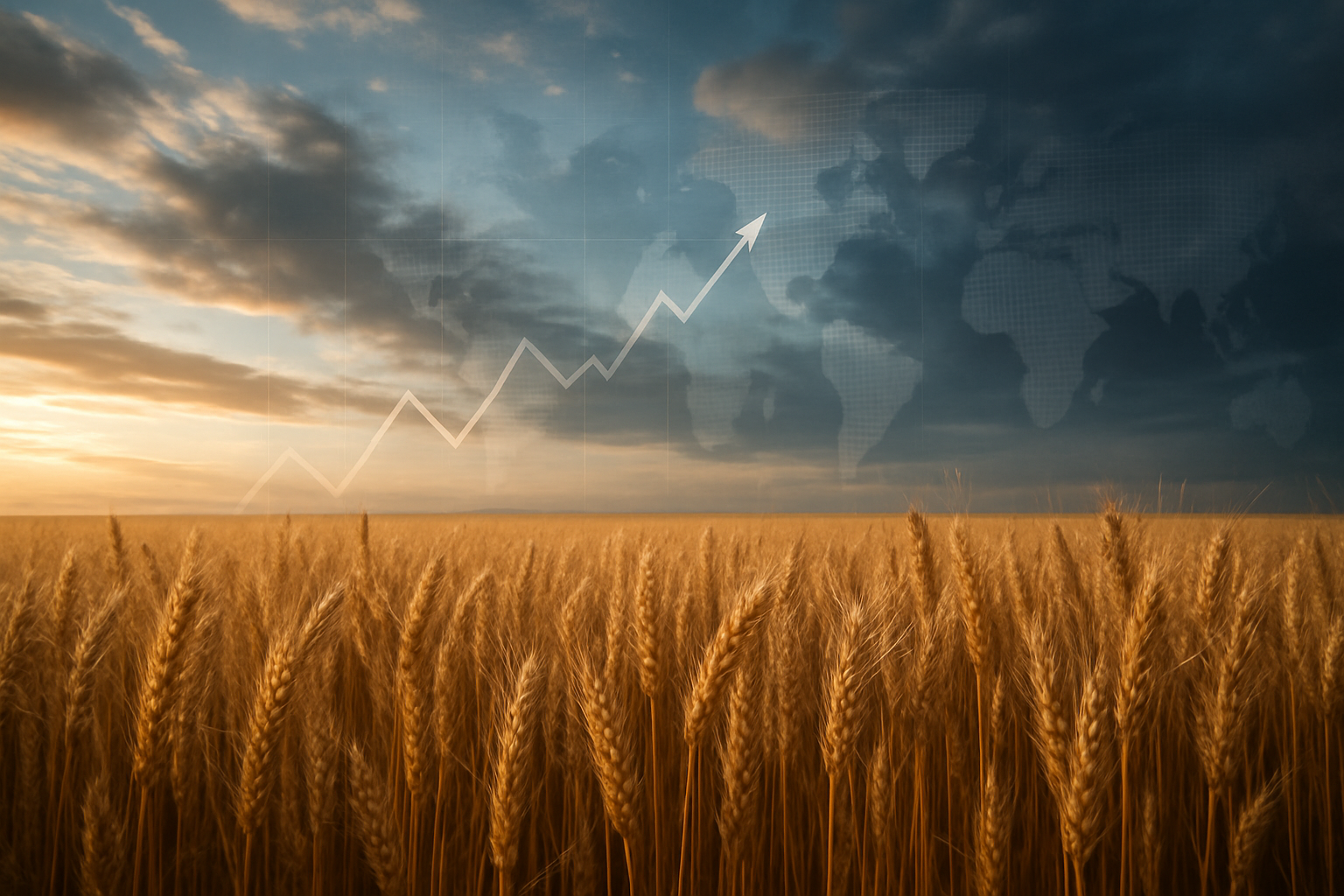
The global wheat market is currently exhibiting a complex and often contradictory performance, marked by significant price fluctuations at midday on October 24, 2025. While ample global supplies are largely keeping prices subdued, geopolitical tensions, speculative trading, and evolving climate patterns are injecting considerable volatility. This mixed dynamic underscores a market grappling with robust production forecasts on one hand and persistent uncertainties that could swiftly alter supply and demand fundamentals on the other.
This period of flux has immediate implications for a range of stakeholders, from individual farmers facing squeezed margins to major food processors benefiting from lower input costs, and ultimately, consumers worldwide. The interplay of these forces suggests that while the current glut may offer some short-term relief in commodity prices, the underlying fragility of the market due to external pressures could lead to rapid shifts, demanding vigilance from all participants.
Detailed Coverage: A Market Under Pressure
On October 24, 2025, wheat futures demonstrated a varied performance across major exchanges. Kansas wheat (HRW) and Chicago wheat (SRW) contracts saw notable rallies, gaining 11.5 cents and 9.25 cents respectively, driven primarily by unconfirmed rumors of China seeking world wheat offers and significant speculative short covering. This upward movement contributed to a slight daily increase of 0.19% in overall wheat prices to 513.99 USd/Bu. However, this modest rise is set against a broader backdrop of decline, with prices having fallen 2.47% over the past month and 9.67% year-over-year, often hovering near five-year lows due to global oversupply. Minneapolis spring wheat futures, conversely, experienced a slip.
Several critical factors are shaping this dynamic. Beyond the China purchase rumors and speculative activity, broader commodity strength, including advances in corn and soybeans, along with a rally in crude oil prices, lent support to wheat. Geopolitical developments, such as escalating sanctions on Russian oil companies and a cooler-than-expected U.S. Consumer Price Index (CPI) data, further influenced market sentiment, hinting at potential interest rate cuts that could broadly support commodity markets. However, the fundamental pressure from abundant global supplies, including large upcoming harvests in Argentina and Russia, and an upward revision of U.S. wheat production, continues to cap significant gains. Ongoing U.S.-China trade tensions, including new tariffs announced earlier in October, also inject uncertainty, potentially reducing demand for U.S. agricultural products. Weather conditions also play a role, with beneficial wet spells in Ukraine and Southwest Russia contrasting with heavy rains posing risks to mature wheat in Eastern Australia and excessive rains delaying planting in the EU.
The timeline leading to this moment reveals a market that has been under pressure for some time. Following the extreme spikes caused by the 2022 Russia-Ukraine conflict, wheat prices have largely retreated to pre-war levels, driven by robust global production and the adaptation of Black Sea export routes. However, the underlying volatility persists, fueled by the ongoing conflict, trade disputes, and the increasing unpredictability of global weather patterns. Key players include major exporting nations like Russia, the U.S., EU, Canada, and Australia, as well as significant importers like China and Egypt, whose purchasing decisions and policies profoundly impact global prices. Initial market reactions reflect caution, with lower trading volumes suggesting less conviction behind the recent price movements, and analysts advising investors to balance short-term gains against persistent long-term risks.
Corporate Fortunes: Who Wins and Who Loses?
The current dynamics in the wheat market, characterized by generally lower prices and abundant supply, create a clear delineation of potential winners and losers among public companies. Food processors and consumer goods companies, as net buyers of wheat, are poised to benefit significantly. Companies like General Mills (NYSE: GIS) and Conagra Brands (NYSE: CAG), which rely heavily on wheat as an input for their packaged foods, stand to see improved profit margins or the ability to offer more competitive pricing. Other major food manufacturers producing bread, pasta, and snacks would also experience a positive impact on their cost of goods sold.
Agricultural giants and grain traders with diversified operations and robust hedging strategies are also well-positioned to navigate the volatility. While privately held, Cargill's reported rebound in fiscal year 2025, driven by efficient global supply chain management and successful export activities, exemplifies this advantage. Publicly traded counterparts like Bunge Global SA (NYSE: BG) and Archer-Daniels-Midland (NYSE: ADM), despite facing broader challenges, leverage their extensive trading and processing capabilities to capitalize on global trade flows and price differences. Their ability to manage inventory and logistics across a global network allows them to mitigate risks associated with price fluctuations and benefit from lower initial purchasing costs for their processing segments.
Conversely, the primary losers from sustained low wheat prices, especially when coupled with high input costs, are individual wheat farmers and companies directly involved in primary wheat production without diversified income streams. Lower market prices directly reduce farmer income, which is further exacerbated by the rising costs of essential inputs like fertilizers, fuel, and labor. This squeeze on profitability can eventually impact agricultural equipment manufacturers like Deere & Company (NYSE: DE), as farmers may delay purchases of new machinery. Companies with less diversified portfolios or high exposure to specific regions experiencing severe climate impacts or significant geopolitical disruptions could also face reduced yields and export challenges. The overall trend favors large, integrated players with global reach and sophisticated risk management, while smaller, specialized producers face increasing financial pressure.
Wider Significance: Beyond the Bushel
The current wheat market dynamics, while immediately focused on price and supply, carry broader significance that extends across industry trends, geopolitical landscapes, and long-term environmental concerns. The prevailing oversupply, leading to multi-year low prices, is a double-edged sword. While it offers a temporary reprieve for food security in importing nations and lowers input costs for food processors, it masks a deeper fragility. Global wheat yields are estimated to be 8-12% lower than they would have been without climate change's influence over the past 50 years, signaling that current bumper harvests may be increasingly vulnerable to future extreme weather events.
Geopolitical tensions continue to reshape global trade flows. Russia's robust export volumes, even with fluctuating production forecasts and reduced quotas, intensify competition and exert downward pressure on global prices, challenging the market share of other major exporters. The European Union's reinstatement of tariff quotas for Ukrainian wheat in June 2025 has forced Ukraine to redirect its exports, depressing prices in traditional markets in North Africa and Southeast Asia. This highlights how policy interventions can significantly alter trade patterns and create new dynamics for both buyers and existing suppliers. Moreover, the ongoing U.S.-China trade tensions, reminiscent of the 2018 trade war, threaten to reduce U.S. agricultural exports and further shift global trade patterns, benefiting competing countries.
Historically, the wheat market has been highly susceptible to political and environmental shocks. The 2022 Russia-Ukraine war, for instance, caused unprecedented price spikes, demonstrating the market's vulnerability to geopolitical disruptions. Even with prices receding, the conflict has created a lasting upward shift in grain price trends. Similarly, historical events like the 1972 Russian grain deal underscore how unexpected large purchases can drastically impact global prices. These precedents emphasize that while current stocks are ample, the market remains highly sensitive to unforeseen production shortfalls or political actions. Regulatory implications include potential adjustments to trade policies, the implementation of strategic grain reserves by governments to stabilize domestic supplies, and a growing trend towards digitalization in agricultural trade to enhance transparency and reduce corruption. The wider significance lies in the heightened sensitivity of global food security to both environmental shocks and political decisions, demanding adaptive strategies from producers, policymakers, and international bodies to mitigate future instability.
What Comes Next: Navigating the Future of Wheat
Looking ahead, the wheat market faces a confluence of short-term volatility and long-term transformative forces. In the short term (2025-2026), continued record global production, particularly from Russia, the EU, and the U.S., is expected to maintain ample supplies, potentially keeping prices subdued despite anticipated modest increases of 5-15% due to rising input costs and robust demand growth. However, geopolitical influences, especially the Black Sea conflict and U.S.-China trade relations, will remain critical drivers of price volatility. Farmers will continue to grapple with high fertilizer, diesel, and seed costs, squeezing profitability. Regional dynamics will see EU production rebound, U.S. exports remain competitive but not dominant, and countries like Egypt actively seeking to diversify their wheat procurement away from over-reliance on single suppliers.
The long-term outlook (2025-2035) projects gradual but steady growth for the wheat market, with a compound annual growth rate (CAGR) of 0.9%, reaching a market valuation of USD 1500 billion by 2035. This growth will be fundamentally shaped by climate change, which poses the most significant long-term risk. Extreme weather events are projected to increase, impacting yields and reducing predictability. Without significant mitigation, up to 60% of current wheat-growing areas could face simultaneous severe water shortages by the century's end. Rising global demand, driven by population growth, particularly in Asia and Africa, will also be a key factor. Technological advancements, including precision farming, genetically modified organisms (GMOs), and advanced irrigation, are seen as crucial for increasing yields and building resilience. The growing adoption of sustainable agricultural practices and the development of climate-resilient wheat varieties will be essential.
Strategic pivots and adaptations are imperative across the value chain. Producers must embrace climate change adaptation strategies, including crop diversification, improved irrigation, and the adoption of heat-tolerant and drought-resistant wheat varieties. Risk management strategies, such as hedging against unpredictable shocks, will be vital for both producers and traders. Diversification of supply chains will become increasingly important to mitigate geopolitical risks, with countries actively seeking new partnerships. Significant investment in agri-tech, including digital solutions and biologicals, will be necessary to enhance yields and resilience. Governments will need to focus on food security, support sustainable farming, and adapt trade policies to evolving global dynamics. Market opportunities will emerge in sustainable and organic wheat, value-added products like whole-wheat flour, and the expanding cultured wheat market, driven by demand for natural preservation solutions. Challenges will persist in the form of climate variability, input cost inflation, geopolitical instability, and intense competition in export markets.
Comprehensive Wrap-Up: A Resilient but Vulnerable Market
In summary, the global wheat market on October 24, 2025, presents a paradox of robust current supply alongside inherent vulnerabilities. Key takeaways include the ongoing pressure on prices due to record global production, particularly from Russia and the EU, which is benefiting food processors but straining farmer profitability. Geopolitical tensions, notably the Black Sea conflict and U.S.-China trade relations, continue to be significant drivers of volatility, reshaping trade flows and export competition. Critically, climate change stands as the paramount long-term threat, with increasing extreme weather events poised to disrupt future yields and food security.
Moving forward, the market is expected to remain highly dynamic and sensitive to external shocks. Investors should watch for further developments in U.S.-China trade negotiations, the effectiveness of Black Sea export corridors, and the severity of weather patterns in key growing regions, particularly in the Southern Hemisphere. The adoption of climate-resilient agricultural practices and continued investment in agri-tech will be crucial for long-term stability. The market will likely continue to favor large, diversified agribusinesses capable of navigating complex global supply chains and employing sophisticated risk management strategies.
Ultimately, the wheat market's ability to balance abundant supply with increasing demand, while simultaneously adapting to the escalating challenges of climate change and geopolitical instability, will define its trajectory in the coming years. While short-term price movements may offer tactical opportunities, the strategic imperative for all stakeholders will be to build resilience and foster sustainable practices to ensure global food security in an increasingly unpredictable world.
This content is intended for informational purposes only and is not financial advice


















